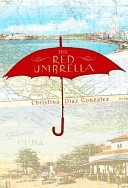
The Red Umbrellais the moving tale of a 14-year-old girl’s journey from Cuba to America as part of Operation Pedro Pan-an organized exodus of more than 14,000 unaccompanied children, whose parents sent them away to escape Fidel Castro’s revolution. In 1961, two years after the Communist revolution, Lucecita Aacute lvarez still leads a carefree life, dreaming of parties and her first crush. But when the soldiers come to her sleepy Cuban town, everything begins to change. Freedoms are stripped away. Neighbors disappear. Her friends feel like strangers. And her family is being watched. As the revolution’s impact becomes more oppressive, Lucecita’s parents make the heart-wrenching decision to send her and her little brother to the United States-on their own. Suddenly plunked down in Nebraska with well-meaning strangers, Lucecita struggles to adapt to a new country, a new language, a new way of life. But what of her old life? Will sheeve see her home or her parents again? And if she does, will she still be the same girl? The Red Umbrellas a moving story of country, culture, family, and the true meaning of home.
- ISBN: 9780375861901
- Author: Gonzalez, Christina Diaz
- Published: 2010 , Random House Childrens Books
- Themes: Culture, Family, Identity
- Descriptors: Caribbean, Cuba, Latin America, Latinx in US, Realistic Fiction, United States, Young Adult (ages 14-18)
- No. of pages: 240

Although this book sounds like a typical story, I would really like to read it. I think seeing the struggles and trials faced by this young girl and her brother would be beneficial for students to read as well as for myself. I love learning more about emigration and trying to see myself in the characters shoes.
I think that The Red Umbrella is an ideal book to demonstrate to students the concept of ‘windows and mirrors.’ The premise of this concept is that “all readers should have opportunities in literature both to see how other people live, think, and perceive the world, and to see their own lives reflected in the characters and topics they encounter” (Bond, 2006, 70). This novel introduces—authentically—life under Castro’s Cuba, which many students would probably be unfamiliar with. This is substantial because, without knowledge about our global neighbors, students will have many challenges to interact and interconnect with others. The novel also gives several opportunities for the reader to perceive their own lived experiences in the novel. For instance, many readers have had the experience of feeling like an outcast, whether it be at school, church, work, etc. When the main character begins school in Kansas, the reader can sympathize with her struggles, so we as readers hold on to the hope that she will overcome her trials.
This is a story that has been repeated many times. We look around and see people, but we never hear their stories. It is easy to relate to Lucia and her brother’s struggles to make friends and a new life in America. We meet immigrants in our daily lives and never stop to consider how many of them are actually refugees fleeing from some unlivable situation. The book is important in that it explains that part of the human experience.
The symbolic connection in red color continues from Red Scarf Girl to The Red Umbrella. Although two protagonists lived in two different countries, China and Cuba, the feelings of confusion, betray, and frustrations are so similar that I experienced Déjà vu from reading Lucia’s story. Lucia’s teen culture is depicted around her range of relationships with her best friends, younger brother and parents. The dynamics with Lucia’s best friend shows typical teenager’s interest in fashion and romance. Thus, how it feels like be betrayed by brainwashed “best” friends appear realistically. Giving power to friends and teen peers is no different from typical teenagers in present time so The Red Umbrella doesn’t seem to be historical but contemporary.
Lucia’s struggle between peer pressure and parents protection reflects historical commonality that young people are the first vulnerable victims from a socio-political paradigm shifts.